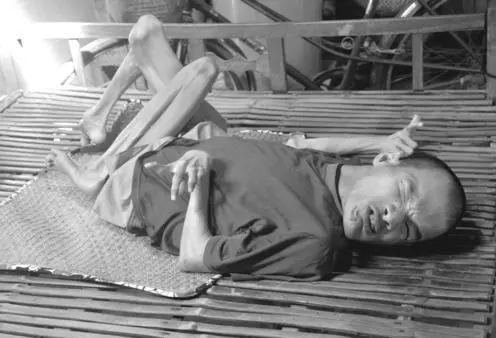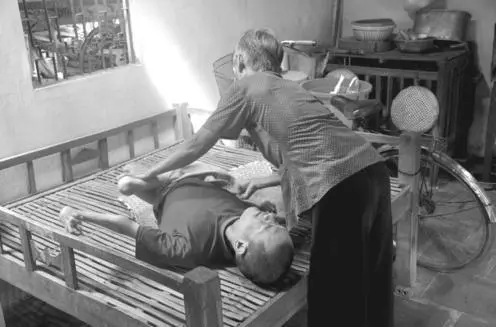I am well aware that some people still blame Vietnam for the war. They are angry because Lyndon Baines Johnson refused to drop an atomic bomb on Hanoi. They hate anyone who fought against the war, and they call veterans who fraternize with former Vietcong North Vietnamese traitors. They say the Vietnamese are still holding American prisoners of war.
This kind of thinking has been an impediment to finding the missing link that will prove, once and for all, that Agent Orange/dioxin maims and kills human beings. I came to Vietnam to write about that missing link, not to reopen wounds or to engage in futile arguments about a war that tore the heart out of my generation. I do not know, nor do I care to know, what men like Le Van Can might have done in the war. He and his family are living with the legacies of chemical warfare. We are human beings; that is our common bond; that is the only thing that should matter now.

Le Van Can’s son
Is there really any difference between the thirty-one-year-old invalid lying on a bamboo bed in Cu Chi and a personal friend of mine who joined the Marines when he was seventeen years old, was leading reconnaissance missions in the Northern I Corps when he was nineteen, and is now dying, slowly and painfully, from Agent Orange-related illnesses? Do American Agent Orange children deserve more help, more love and kindness, than those who lie twisted, blind, and deaf upon pallets and floors and bamboo beds throughout Vietnam?
Before he left for the war, Le Van Can fathered one normal child. When he returned, his wife carried three of their children. One died before it was born, another lived for several days, and still another survived for three years. Their son has lived for thirty-one years.
This man and his wife have allowed us to visit their home, where we photograph their seriously deformed son, and ask questions that must cause them pain. They survive through help from the Red Cross and donations from others. People come and go, curious to know if the stories they’ve heard about chemical warfare can possibly be true. Shocked by what they see and hear, they return home determined to help victims of Agent Orange. Sometimes these people follow through on promises to write their representatives, to raise money, or to do what they can to persuade the chemical manufacturers of Agent Orange to use some of their profits to help Vietnamese families.
Le Van Can lights a cigarette and we shake hands across the concrete table at which we’ve been sitting. I ask our interpreter to say that I am sorry that Mr. Can and his family are suffering from the effects of chemical warfare. She talks for a long time, the blind man nods once and does not say anything more.
Many years before this trip to Vietnam, I spent an evening with a Vietnam veteran who served with a psychological warfare (PSYOPS) unit.
“We used to play tapes from loudspeakers,” my host told me, “basically saying that the VC were telling the people that herbicides were making them sick and that the spraying was responsible for their miscarriages and illnesses. And the tapes would say that the VC are lying, that they just don’t like the sprays because it makes it hard for them to hide, and that the VC are actually poisoning people’s water so the people will think it’s the herbicides that are making them sick.
“I was young and gung-ho at the time; so I just believed the propaganda we were feeding the people. We heard the Vietnamese complain. They talked about depressions, diarrhea, colds, rashes, and spontaneous abortions. But it was a war zone, and we just figured there were a lot of diseases that we had never heard of.
“Thinking back, I recall being struck by the number of children with cleft palates. And I suffered from the same things over and over, screaming pains in my joints, pains in my gut, blood in my urine, my feet going numb. But the hardest thing to deal with was the sudden depressions that came on you. You just wanted to go out into a field and stick a pistol in your mouth and pull the trigger.” 4
Years before the United States launched its scorched earth campaign in Vietnam, scientists for Dow Chemical, one of the principal manufacturers of Agent Orange, were aware that dioxin is teratogenic and fetotoxic in rats and mice. In numerous studies over a period of decades, scientists have repeatedly shown that laboratory animals exposed to minute quantities of dioxin suffer catastrophic consequences.
In an exhaustive research paper, “Association between Agent Orange and Birth Defects: Systematic Review and Meta-Analysis,” the authors write:
Results of this meta-analysis combining data from twenty-two studies support the hypothesis that exposure to Agent Orange is associated with a statistically significant increase in the risk of birth defects, with a significant heterogeneity of effects across study populations. The result complements a previous finding that the risk of spina bifida, a specific birth defect, was elevated with Agent Orange exposure. 5
The results of their study were:
consistent with previous animal studies. Indeed, the detrimental effect of dioxin on congenital malformations has been documented in animal studies in which dioxin was shown to act as either a teratogen or mutagen.
For example, maternal exposure to dioxin resulted in cleft palate and hydronephrosis in mice and hamsters, intestinal hemorrhage and renal abnormalities in rats, 61 extra ribs in rabbits, and spontaneous abortions in monkeys.
There is evidence that mutagenic effects of dioxin can take place at the genetic level. Dioxin was found to cause chromosomal anomalies in the bone marrow cells of some specific strains of rats and mice, and stimulate RNA synthesis in rat liver. Evidence from animal studies indicates that the observed association between Agent Orange/dioxin and birth defects in humans seems biologically plausible…. among populations exposed to Agent Orange, an elevated incidence of birth defects may have occurred…. Findings from this meta-analysis support the hypothesis that exposure to Agent Orange is associated with a statistically significant increase in risk of birth defects. The biological mechanism of this association and methodological limitations of Vietnamese studies warrant the consideration of conducting a large-scale and well-designed study in heavily sprayed regions of Vietnam to further elucidate the etiology of the Agent Orange and birth defects relationship. Future studies need to include biological measures of exposure. The long half-life of dioxin makes this possible even now. 6
Our interpreter tells the family goodbye and I attempt to thank the woman of the house for the tea, but she has gone into the next room to care for her son.
Walking along a path back to the road, we stop to admire neat rows of bright green vines, perhaps cucumbers, soaking up the sun. It is noon, we are hungry, and have no idea where we might be going next, or how the men who accompany us manage to arrange these meetings with the people who do not have telephones or computers. Brendan stops to adjust his camera.
“Jesus, dad, he’s my age, isn’t he?” he asks.
“Yes, he’s your age,” I say. “Thirty-one years old.”
“Thirty-one years old.”
“And all that time, he’s just been there.”

Mother and child
“Just there.”
The ex-soldiers who accompany us climb into their car and we follow them along the dusty roads of Cu Chi district. Once, wild animals roamed this region’s forests. We pass rice paddies, clumps of trees, heaps of rubbish. A dog. Two water buffalo. Overhead, the ubiquitous electric wires that mar Vietnam’s natural beauty.
Читать дальше














